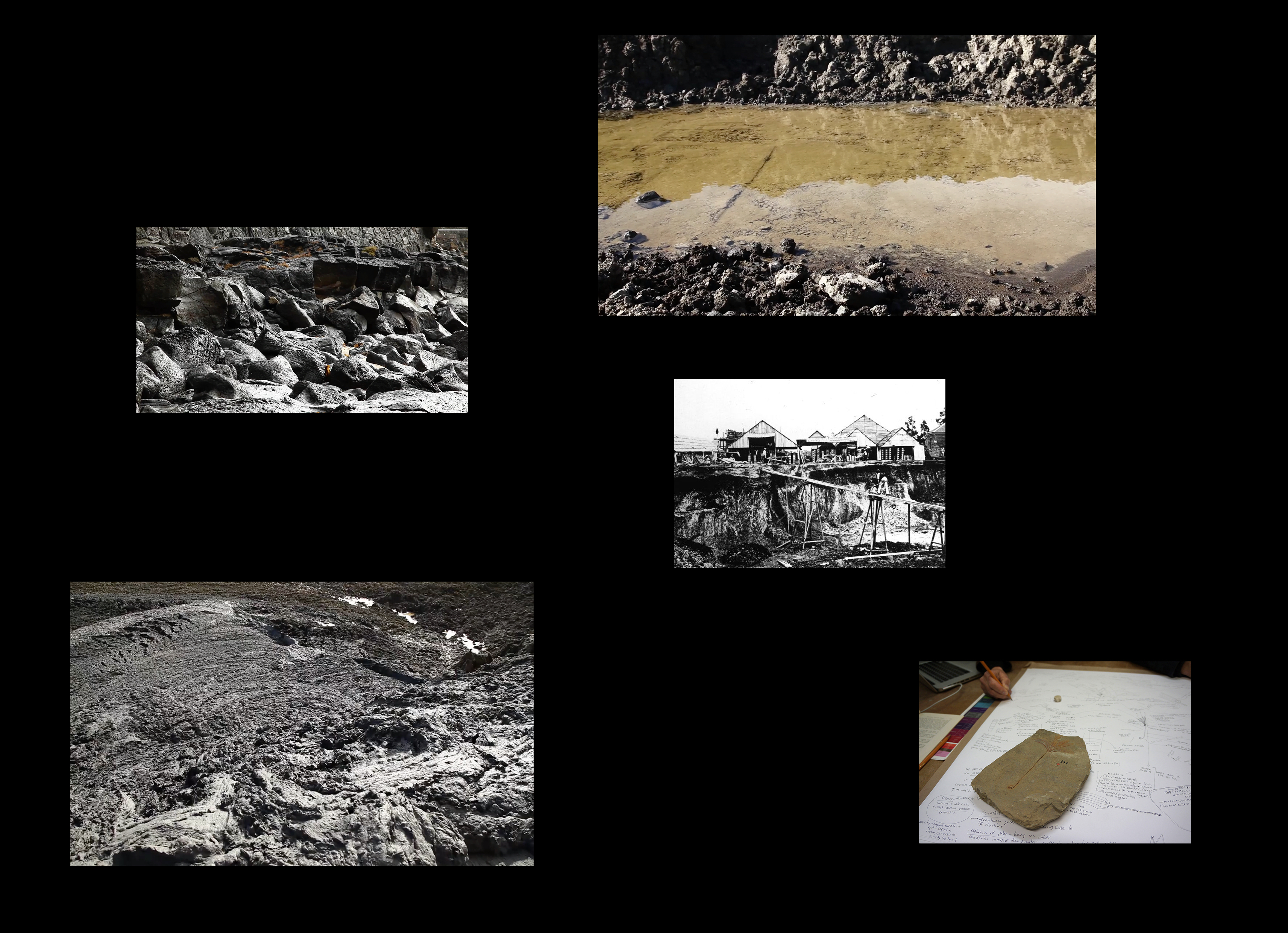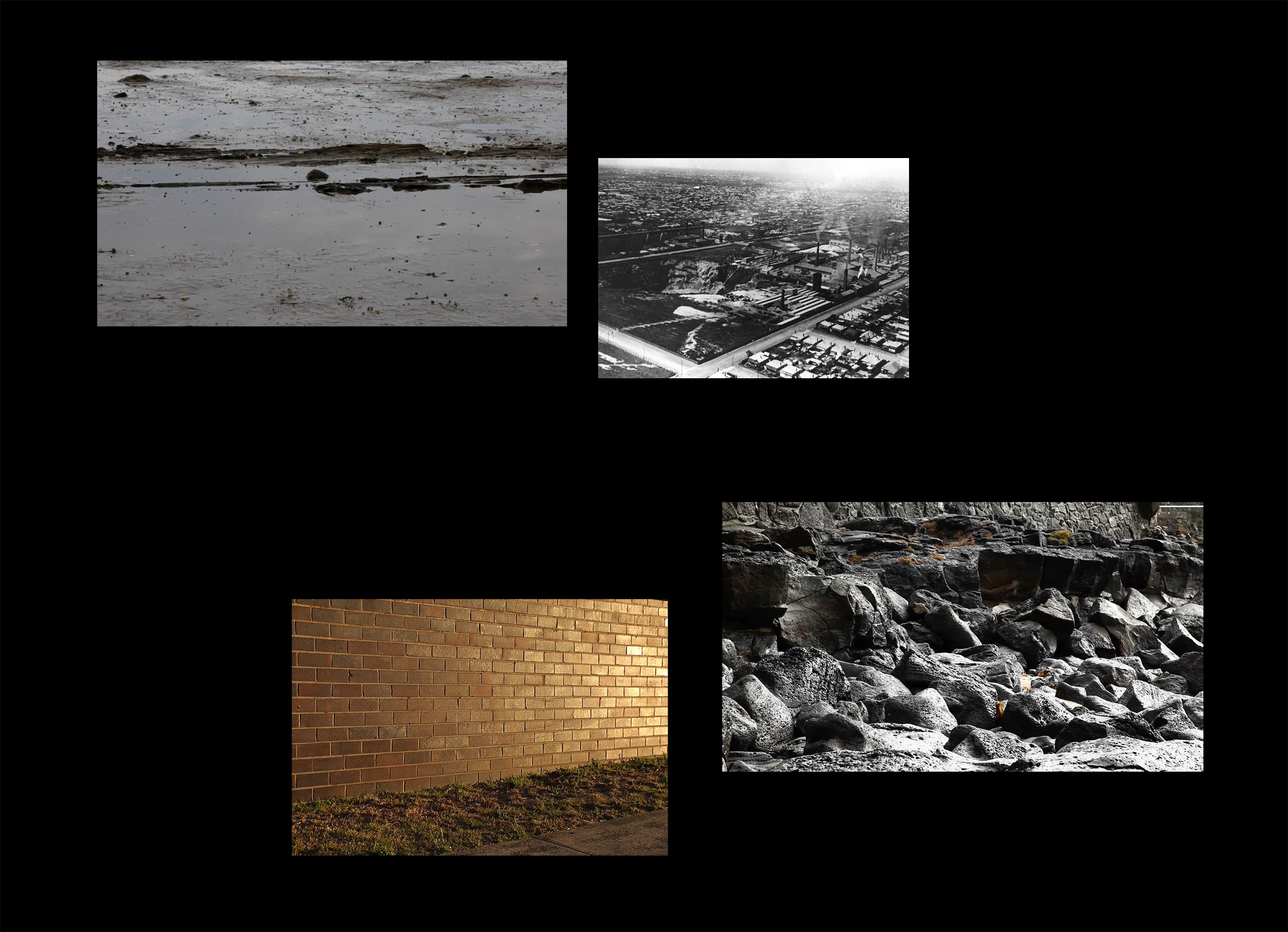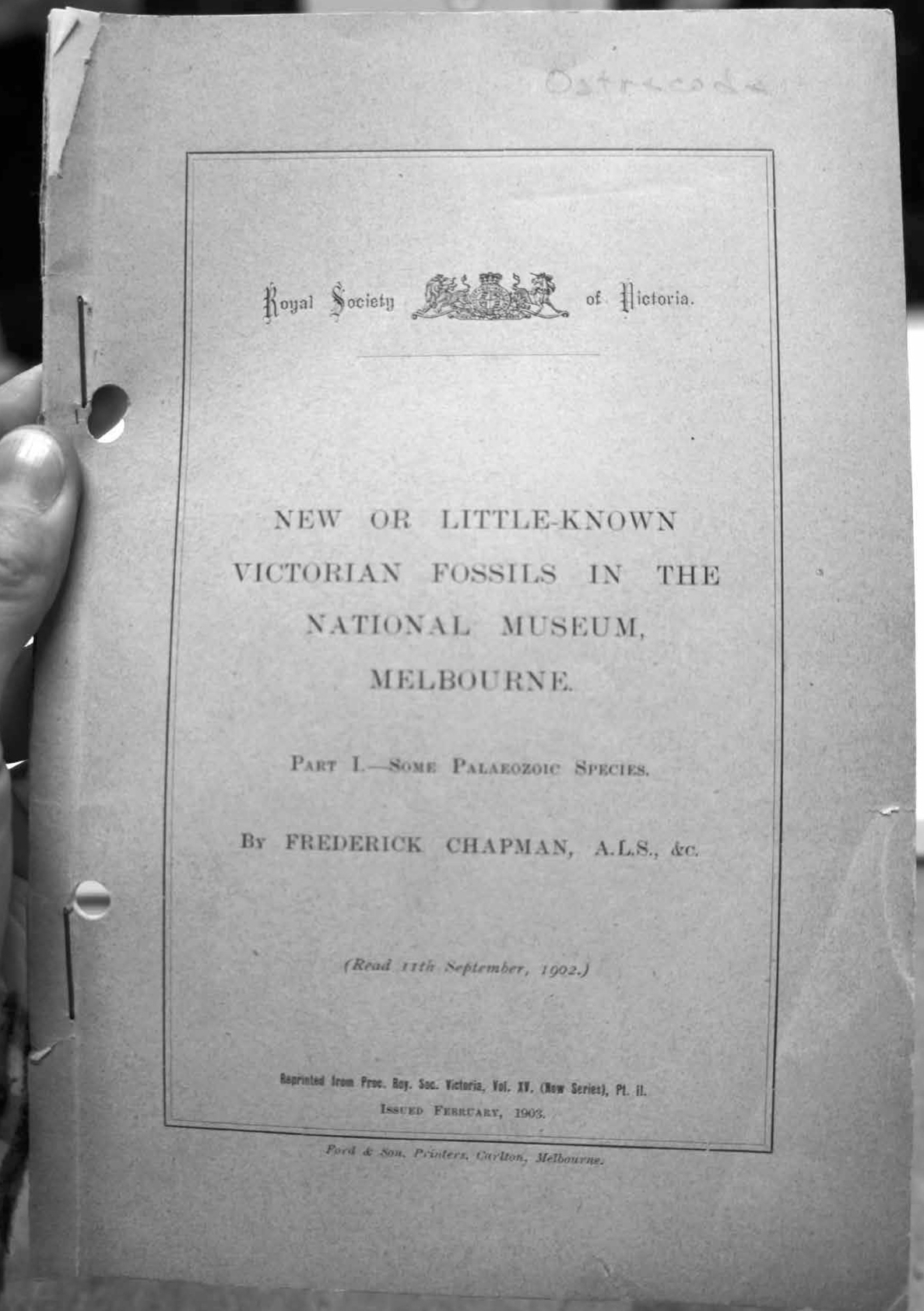Performing Mobilities:
Traces, curated by Mick Douglas,
Storey Hall RMIT University Gallery, Melbourne 25-09 to 24-10-2015
FAULT investigates the multiple temporalities that matter registers through forces of contraction, dilation, folding, compression and erosion. Through video-collage, OSW explores the convergence of these forces that give rise to an earth that is ‘indelibly inscribed’ (Claire Colebrook). Anchored around the material specificity of a geological specimen, this work follows fissures that expose glimpses of differing tempos resonating from events that knot together accumulation and extinguishment.
Beginning with a Sea Lily fossil (1) selected from the Natural Sciences collection at Museum Victoria, OSW presents a video-work of ‘temporal-fragments’ that visualise the movements of matter across durations, and complex convergences brought into relation by the specimen. Approached through the framework provided by the Sea Lily fossil, matter’s movement includes the massive sea-floor landslides and tectonic subduction that occurred over millennia, which contributed to the formation of the Eastern Australian coastline. The Sea Lily specimen persists as a tiny material remainder registering these processes, whilst also connecting with recent anthropogenic activity.
The circa 1903 event of this fossil’s excavation is contingent upon the brick-making industry reliant on the clay reserves that dominated West Brunswick. Formed by the ancient landslides taking place before the emergence of homo-sapiens, this clay provided the primary material for the Hoffman’s brickworks, a key supplier meeting Melbourne’s brick requirements in post gold rush development. The hunger for clay generated two extensive excavations on either side of Albert Street (2), which widened proportionate to the surge in Melbourne’s built fabric.
The Sea Lily fossil has stimulated a process of temporal excavation through such relations, making apparent materiality’s complex durational qualities, and entanglements with the politics of extraction, forces of production, geo-bio-human history, energy and economies.
(1) The particular fossil is a ‘holotype’ providing the initial description of its kind.
(2) The first excavation was backfilled with domestic refuse from 1947.
FAULT investigates the multiple temporalities that matter registers through forces of contraction, dilation, folding, compression and erosion. Through video-collage, OSW explores the convergence of these forces that give rise to an earth that is ‘indelibly inscribed’ (Claire Colebrook). Anchored around the material specificity of a geological specimen, this work follows fissures that expose glimpses of differing tempos resonating from events that knot together accumulation and extinguishment.
Beginning with a Sea Lily fossil (1) selected from the Natural Sciences collection at Museum Victoria, OSW presents a video-work of ‘temporal-fragments’ that visualise the movements of matter across durations, and complex convergences brought into relation by the specimen. Approached through the framework provided by the Sea Lily fossil, matter’s movement includes the massive sea-floor landslides and tectonic subduction that occurred over millennia, which contributed to the formation of the Eastern Australian coastline. The Sea Lily specimen persists as a tiny material remainder registering these processes, whilst also connecting with recent anthropogenic activity.
The circa 1903 event of this fossil’s excavation is contingent upon the brick-making industry reliant on the clay reserves that dominated West Brunswick. Formed by the ancient landslides taking place before the emergence of homo-sapiens, this clay provided the primary material for the Hoffman’s brickworks, a key supplier meeting Melbourne’s brick requirements in post gold rush development. The hunger for clay generated two extensive excavations on either side of Albert Street (2), which widened proportionate to the surge in Melbourne’s built fabric.
The Sea Lily fossil has stimulated a process of temporal excavation through such relations, making apparent materiality’s complex durational qualities, and entanglements with the politics of extraction, forces of production, geo-bio-human history, energy and economies.
(1) The particular fossil is a ‘holotype’ providing the initial description of its kind.
(2) The first excavation was backfilled with domestic refuse from 1947.





542 - 488 million years ago
At the beginning of the current geologic eon, when multi-cellular life diversified greatly particularly amongst marine species, a landmass is forming at the level of the sea-floor on the eastern edge of a supercontinent. This edge, its most westerly boundary now marked by the Flinders Ranges, is built through successive volcanic eruptions and intermittent accumulations of sand and mud that washes off the supercontinent. Over millennia these accumulations provide the material for the formation of sedimentary rocks that in turn are compressed, heated and driven upwards along fault lines. Traces of this process are preserved as greenstones found throughout present day Western Victoria.
At the beginning of the current geologic eon, when multi-cellular life diversified greatly particularly amongst marine species, a landmass is forming at the level of the sea-floor on the eastern edge of a supercontinent. This edge, its most westerly boundary now marked by the Flinders Ranges, is built through successive volcanic eruptions and intermittent accumulations of sand and mud that washes off the supercontinent. Over millennia these accumulations provide the material for the formation of sedimentary rocks that in turn are compressed, heated and driven upwards along fault lines. Traces of this process are preserved as greenstones found throughout present day Western Victoria.
488 - 443 million years ago
During this period sea levels are high and shallow seas cover much of the land. Parts of present day Victoria are forming through processes of deep marine sedimentation. Underwater landslides cause vast amounts of material to collect at the base of continental slopes burying marine creatures such as the Crinoids – or sea lilies. Crinoids evolved in this period and existed in superabundance on the seafloor, their remains decomposing over millennia in what would become the clay pits of Brunswick and limestone forma- tions of Lilydale and Buchan.
443 - 416 million years ago
The building of what will become south-eastern Australia continues, dominated by an east-west shortening of predominantly oceanic sedimentary and volcanic rocks and their consequent folding, faulting and uplift. A number of structural windows in the Melbourne zone, such as that at Dight’s Falls, expose rocks from this period, which are some of the oldest rocks on the mainland.
385 million - 380 million years ago
For millions of years extensive rifts have affected the major fold belts that make up present day Victoria causing multiple deforma- tions including faults and basins. Throughout this time the Melbourne Zone has been largely unaffected and thick sediments have accumulated without interruption. 385 million years ago the situation changes and the Melbourne Zone experiences a period of major deformation.
385 million - 380 million years ago
For millions of years extensive rifts have affected the major fold belts that make up present day Victoria causing multiple deforma- tions including faults and basins. Throughout this time the Melbourne Zone has been largely unaffected and thick sediments have accumulated without interruption. 385 million years ago the situation changes and the Melbourne Zone experiences a period of major deformation.
299 million - 251 million years ago
The supercontinent Pangaea, incorporating Gondwana, is fully assembled straddling the equator and surrounded by a global ocean called Panthalassa. Glaciers scourer rock surfaces and ice covers most of Victoria. By the end of this period the earth’s climate is very dry, nearly 70% of terrestrial and 96% of marine species have died out forming rich fossil deposits from the earths third and most severe mass extinction event.
199 million – 145 million years ago
Early signs of a rift forming in the Gondwana landmass between Australia and Antarctica become evident, delineating for the first time what would become the Australian continent.
141 - 65 million years ago
During this period the Otway and Gippsland basins form across the southern margin rift between Australia and Antarctica. At about 100 million years large parts of the Australian continent are submerged beneath a marine transgression. Not long after, a wide belt of continental crust is uplifting along the eastern highlands and at approximately 80 million years Australia and New Zealand separate. The end of this period brings another mass extinction with a 75% reduction in life forms.
65 - 23 million years ago
Large reserves of fossil fuels (coal, gas and oil) are formed in the Otway, Bass and Gippsland Basins. Australia separates from Ant- arctica between 37 and 33.5 million years ago and drifts northward creating the Antarctic Circumpolar Current, which contributes to the evolution of the earth’s present climate.
5.3 – 2 million years ago
The most recent period of sustained volcanic activity sees thick sheets of basalt lava approach the Melbourne zone from the Keilor and Werribee Plains in the west, with activity to the north filling the Moonee Ponds, Merri and Darebin creeks.
40,000 – 22,000 years ago
Australia is part of the Sahulland land mass including New Guinea and Tasmania. The Wurundjeri people occupy the Birrarung Valley around the area currently known as Keilor. During this period the climate is wetter than it would become during the last gla- cial period. The continent is at its coldest and driest around 22,000 years ago with half the continent covered in shifting sand dunes and areas around Mount Kosciuszko and Tasmania covered in ice.
8,000 – 6,000 years ago
The end of the last glacial period, sea levels rise, gradually flooding the Bassian Plain, which joins Tasmania to the mainland and forming what is now known as Port Phillip Bay. This event is recorded in creation stories of the Wada Wurrung, Woiwurrung and Bun Wurrung of the Kulin Nation.
1,500 years agoMoonee Ponds Creek valley provides a major route to Northern Victoria, where metabasalt, or greenstones, are mined at Mt. Wil- liam for use in hatchet heads and traded across the continent.
Pre 1835
Brunswick is a small plateau tilting from a hill facing the Moonee Ponds Creek in the west to the Merri Creek in the east, timbered by eucalypt trees with poor drainage making the terrain swampy. To the north, grasslands predominate with up to a hundred and fifty six different species in existence. Murnong – yam daisy – proliferated across the plains from Melbourne towards the snowline of the great dividing ranges, and provide a staple food for the Woiwurrung of the Moreland area.
1835After decades of informal incursions by sealers, Batman’s ‘treaty’ marks the beginning of official occupation. Melbourne becomes the location from which violent possession of much of southern and central Victoria is taken from its indigenous owners and sub- sequently colonised.
1839 – 1841Land north of Royal Park is surveyed for farming. Chief surveyor Robert Hoddle overseas its division into 20 allotments running east and west from the main thoroughfare, which at the time is thought to be too narrow. Marked upon the grasslands, blocks one and a half miles long and a quarter mile wide are auctioned in 1839. Most are sold to speculators who hope to sub-divide and quickly sell them on. The central block on the eastern side is resold to Thomas Wilkinson and Edward Stone Parker in 1841. They name their estate Brunswick Park and sub-divide the land for sale or rental, naming the boarding streets Victoria and Albert Streets in honour of the recent royal wedding.
1850 – 1870Property owners divide their land as they see fit and grazing devastates the grasslands and its ecosystems. At the same time the eradication of the marshlands decimate the complex systems of flora and fauna. As a consequence many species disappear includ- ing swans, brolgas, magpie-geese, and over twenty migratory bird species. The rich basalt layer provides the first quarries with abundant bluestone for the city’s buildings and the reserves of clay supply a burgeoning brick industry responding to the rapid de- velopment of Melbourne as the gold rush takes hold. By 1870 eight brick yards are in operation, the largest is in Albert Street called the Hoffman Patent Steam Brick and Tile Company, one of the first mechanised brickworks in Australia.
1880’sCoinciding with the Melbourne land boom Hoffman’s open a second site in Dawson Street in 1883. The business thrives as they continue to pioneer the industrialisation of brickmaking. They introduce steam powered technology that revolutionizes the indus - try with powered brick presses and imported kilns enabling heightened levels of productivity. By 1884 a train runs to Coburg and Hoffman’s build their own line and siding running directly into the brickworks. Hundreds of labourers are employed in brickmak- ing and associated pottery industries and the Hoffman’s factory whistle reminds them every morning at 7:15 am. The success of this business makes Brunswick the brickmaking capital of Victoria.
1897The first labour based political organisation forms in 1897, the Brunswick branch of the United Labour Party. The future Australian Prime Minister, John Curtin joined the Brunswick branch, as a pottery industry worker.
1903 – 1914Frederick Chapman, palaeontologist to the National Museum, Melbourne names the crinoid or sea lily fossil, found in Silurian mudstone at a Brunswick clay pit associated with the Hoffman’s Brickworks - Helicocrinus plumosus. The fossil dates from approx- imately 415 million years ago. Chapman describes it as “a delicate and handsome species, having a small cup with finely pinnate arms, which are forked once, and with a pentagonal stem coiled at the distal end” (136). Chapman later uses it as the Frontispiece for his book Australasian Fossils. A student manual of Palaeontology published in 1914.
1914 +
Consolidation of brick manufacturing operations, reduced demand due to the depression and diminishing clay supplies sees a number of Brunswick brick factories close. Parks are developed over several former clay pits while others are used as municipal rubbish tips. Beginning in 1947, the Hoffman’s number one pit takes 17 years to fill with rubbish. In 1981 it becomes M. W. Clifton Reserve.